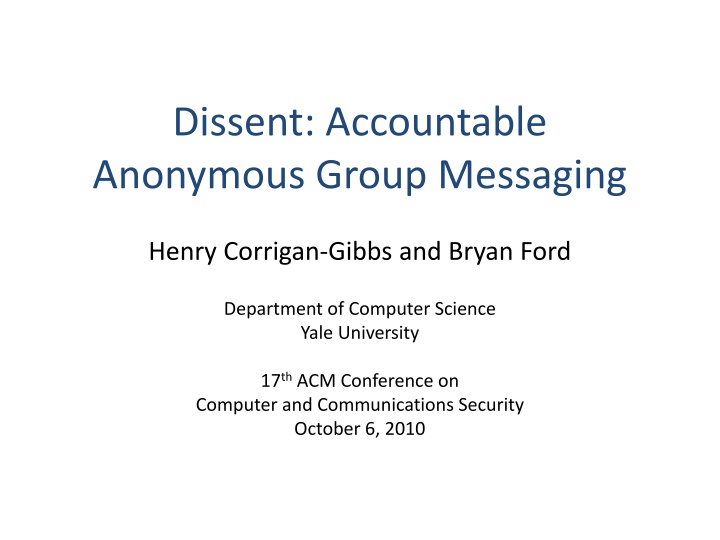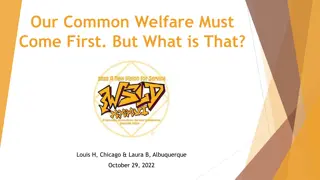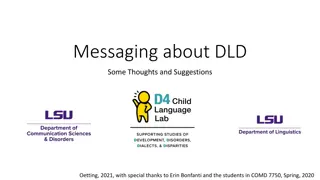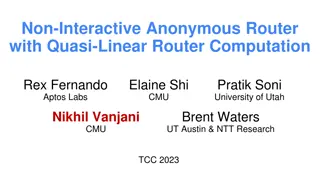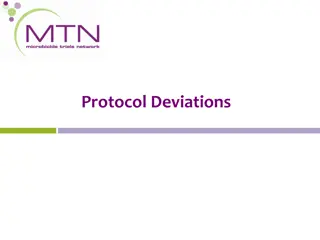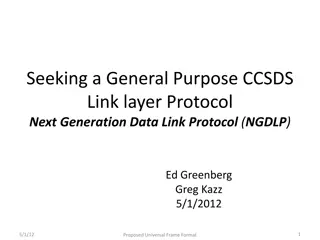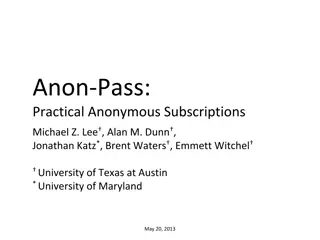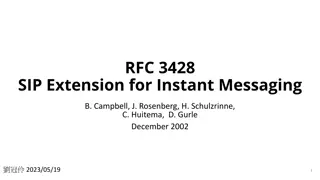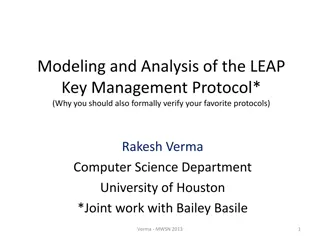Ensuring Anonymous Group Messaging with Dissent Protocol
This research explores Dissent, an accountable and anonymous group messaging protocol developed by Henry Corrigan-Gibbs and Bryan Ford from Yale University. It addresses challenges of communicating efficiently and anonymously in public network settings where Eve may attempt to block communication, and messages vary in length. Limitations of existing schemes are highlighted, and the Dissent protocol's variable-length shuffle and fixed-length shuffle components are discussed, along with goals for future improvements.
Uploaded on Feb 27, 2025 | 0 Views
Download Presentation

Please find below an Image/Link to download the presentation.
The content on the website is provided AS IS for your information and personal use only. It may not be sold, licensed, or shared on other websites without obtaining consent from the author.If you encounter any issues during the download, it is possible that the publisher has removed the file from their server.
You are allowed to download the files provided on this website for personal or commercial use, subject to the condition that they are used lawfully. All files are the property of their respective owners.
The content on the website is provided AS IS for your information and personal use only. It may not be sold, licensed, or shared on other websites without obtaining consent from the author.
E N D
Presentation Transcript
Dissent: Accountable Anonymous Group Messaging Henry Corrigan-Gibbs and Bryan Ford Department of Computer Science Yale University 17th ACM Conference on Computer and Communications Security October 6, 2010
Wikileaks Problem Bob Alice Eve Chris Image courtesy NASA Johnson Space Center
Bob Alice Eve Chris
Bob Alice Has a 646 MB classified military video from Iraq Eve Chris
Bob Alice Is this video authentic? Eve Chris
Bob Alice Wants to: 1. Anonymously publish video to the group 2. Solicit anonymous comments Eve Chris
Bob Alice Eve Chris
Wants to: 1. Break anonymity 2. Stop initial video publication 3. Alter Alice and Bob s reviews 4. Submit many bad reviews Bob Alice Eve Chris
The Question How can group members communicate efficiently and anonymously when: 1. all network communication is public, 2. Eve wants to block communication, and 3. group members messages are of vastly different lengths?
Limitations of Existing Schemes Method Weakness Traffic analysis attacks Traffic analysis attacks Mix Nets, Tor Group and Ring Signatures Voting Protocols Short, fixed-length messages Anonymous DoS attacks Anonymous DoS attacks and fixed message length DC Nets Brickell-Shmatikov Shuffle
Outline Introduction to Dissent How Dissent works Overall protocol: Variable-length shuffle Key component: Fixed-length shuffle Prototype and experimental results Goals for future work
Outline Introduction to Dissent How Dissent works Overall protocol: Variable-length shuffle Key component: Fixed-length shuffle Prototype and experimental results Goals for future work
Dissent Dissent is a protocol for latency-tolerant sender- anonymous broadcast within a pre-defined group of nodes: 1. Each group member secretly submits one message per protocol round 2. Group members run the protocol 3. The protocol reveals to all members a permutation of the message set 4. No group member knows the permutation We call this a shuffle protocol
Dissent guarantees Integrity: Messages are received unmodified Anonymity: To identify the sender of a message, all other members must collude Accountability: Members interfering with message transmission will eventually be identified N.B.: These definitions are very informal. Please refer to our paper for precise definitions.
Our Contributions Dissent builds upon the Brickell-Shmatikov anonymous data collection protocol (KDD 2006), adding: 1. Accountability: Alice, Bob, and Chris can identify Eve if she tries to alter messages or block protocol progress 2. Communication efficiency with variable- length messages: Group members do not have to pad their messages to a fixed length
Outline Introduction to Dissent How Dissent works Overall protocol: Variable-length shuffle Key component: Fixed-length shuffle Prototype and experimental results Goals for future work
Conceptual Description Follows one group member (Chris) and his 646 MB video Every other group member follows the same steps as Chris in parallel We assume: Every member has a signature verification key for every other group member Existence of a wrapper protocol handling group membership, liveness, protocol initiation, etc. (See paper for details on the wrapper.)
Issue 1: Traffic Analysis How can Chris broadcast his 646 MB video anonymously if attackers are listening in? Neither message structure nor length should identify Chris as the true sender Therefore: All other group members must also broadcast a 646 MB message Messages should look like random strings
Issue 1: Traffic Analysis Publish zxmnco ak929j9 aksjdq9 wldk0w alkj38f8 2hlkd02 9sjlkjd0 981lkjlkj vmdnv mdnduu z093ufoi lkjksdlka 0988j4fk skjdcka8 3masjkjs dlkqwkd Alice Bob Chris Eve
Issue 2: Recovery How can members recover Chris video from the 646 MB random-looking strings? Assume Alice, Bob, and Eve send pseudo- random strings known to Chris Then: Chris sends the XOR of his video with Alice, Bob, and Eve s pseudo-random strings i.e., three serial one-time pad encryptions Reminiscent of Chaum s DC net
Issue 2: Recovery The 646MB Video zxmnco ak929j9 aksjdq9 wldk0w alkj38f8 2hlkd02 9sjlkjd0 981lkjlkj vmdnv mdnduu z093ufoi lkjksdlka 0988j4fk skjdcka8 3masjkjs dlkqwkd Alice Bob Chris Eve
Issue 3: Assignment How can Chris efficiently assign 646 MB strings to Alice, Bob, and Eve? Chris anonymously broadcasts (somehow) a table of assignments along with the length of his message Each assignment contains: A PRF seed encrypted for each member A cleartext hash of the string assigned to each member
Issue 3: Assignment Length: 0 bytes Length: 646 MB Length: 0 bytes Length: 0 bytes Seed Hash Seed Hash Seed Hash Seed Hash {v9ek}A 2d2t {dkad}A 092f {dsfr}A d1fs {dfwv}A td82 A A A A {2fva}B nve0 {f23d}B f9ja {fv24}B hvae {ert3}B 3flk B B B B {afbf}C 3ren {d3g5}C jh2m {sdfb}C 0jd2 {09fg}C df3f C C C C {d2g5}E sdvz {afef}E vnsk {s5eg}E fewh {fg4h}E vce3 E E E E Alice Bob Chris Eve
Issue 3: Assignment Length: 646 MB Enc. Seed Hash A {dkad}A 092f B {f23d}B f9ja C {d3g5}C jh2m Length: 0 bytes E Length: 646 MB vnsk Length: 0 bytes Length: 0 bytes Hash {afef}E Seed Seed Hash Seed Hash Seed Hash {v9ek}A 2d2t {dkad}A 092f {dsfr}A d1fs {dfwv}A td82 A A A A {2fva}B nve0 {f23d}B f9ja {fv24}B hvae {ert3}B 3flk B B B B {afbf}C 3ren {d3g5}C jh2m {sdfb}C 0jd2 {09fg}C df3f C C C C {d2g5}E sdvz {afef}E vnsk {s5eg}E fewh {fg4h}E vce3 E E E E Alice Bob Chris Eve
Issue 3: Assignment Length: 0 bytes Enc. Seed Hash Publish {dfwv}A A td82 B {ert3}B 3flk C {09fg}C df3f Length: 0 bytes E Length: 646 MB vce3 Length: 0 bytes Length: 0 bytes Hash {fg4h}E Seed Seed Hash Seed Hash Seed Hash {v9ek}A 2d2t {dkad}A 092f {dsfr}A d1fs {dfwv}A td82 A A A A {2fva}B nve0 {f23d}B f9ja {fv24}B hvae {ert3}B 3flk B B B B {afbf}C 3ren {d3g5}C jh2m {sdfb}C 0jd2 {09fg}C df3f C C C C {d2g5}E sdvz {afef}E vnsk {s5eg}E fewh {fg4h}E vce3 E E E E Alice Bob Chris Eve
Issue 3: Assignment Length: 0 bytes Enc. Seed Hash A {v9ek}A 2d2t B {2fva}B nve0 C {afbf}C 3ren Length: 0 bytes E Length: 646 MB sdvz Length: 0 bytes Length: 0 bytes Hash {d2g5}E Seed Seed Hash Seed Hash Seed Hash {v9ek}A 2d2t {dkad}A 092f {dsfr}A d1fs {dfwv}A td82 A A A A {2fva}B nve0 {f23d}B f9ja {fv24}B hvae {ert3}B 3flk B B B B {afbf}C 3ren {d3g5}C jh2m {sdfb}C 0jd2 {09fg}C df3f C C C C {d2g5}E sdvz {afef}E vnsk {s5eg}E fewh {fg4h}E vce3 E E E E Alice Bob Chris Eve
Issue 3: Assignment Length: 0 bytes Enc. Seed Hash A {dsfr}A d1fs B {fv24}B hvae C {sdfb}C 0jd2 Length: 0 bytes E Length: 646 MB fewh Length: 0 bytes Length: 0 bytes Hash {s5eg}E Seed Seed Hash Seed Hash Seed Hash {v9ek}A 2d2t {dkad}A 092f {dsfr}A d1fs {dfwv}A td82 A A A A {2fva}B nve0 {f23d}B f9ja {fv24}B hvae {ert3}B 3flk B B B B {afbf}C 3ren {d3g5}C jh2m {sdfb}C 0jd2 {09fg}C df3f C C C C {d2g5}E sdvz {afef}E vnsk {s5eg}E fewh {fg4h}E vce3 E E E E Alice Bob Chris Eve
Issue 3: Assignment Length: 0 bytes Length: 646 MB Length: 0 bytes Length: 0 bytes Seed Hash Seed Hash Seed Hash Seed Hash {v9ek}A 2d2t {dkad}A 092f {dsfr}A d1fs {dfwv}A td82 A A A A {2fva}B nve0 {f23d}B f9ja {fv24}B hvae {ert3}B 3flk B B B B {afbf}C 3ren {d3g5}C jh2m {sdfb}C 0jd2 {09fg}C df3f C C C C {d2g5}E sdvz {afef}E vnsk {s5eg}E fewh {fg4h}E vce3 E E E E Alice Bob Chris Eve
Issue 3: Assignment Publish Length: 0 bytes Length: 646 MB Length: 0 bytes Length: 0 bytes Seed Hash Seed Hash Seed Hash Seed Hash {v9ek}A 2d2t {dkad}A 092f {dsfr}A d1fs {dfwv}A td82 A A A A {2fva}B nve0 {f23d}B f9ja {fv24}B hvae {ert3}B 3flk B B B B {afbf}C 3ren {d3g5}C jh2m {sdfb}C 0jd2 {09fg}C df3f C C C C {d2g5}E sdvz {afef}E vnsk {s5eg}E fewh {fg4h}E vce3 E E E E Alice Bob Chris Eve
Issue 4: Anonymity How can Chris transmit his assignment table anonymously? The assignment contains the length of Chris message, so it must not be traceable to him Dissent uses a modification of the Brickell- Shamikov data collection protocol to shuffle the fixed-length assignment tables Final ordering of tables determines ordering in which members broadcast their pseudo-random strings
Issue 4: Anonymity Fixed-length Shuffle Length: 0 bytes Length: 646 MB Length: 0 bytes Length: 0 bytes Seed Hash Seed Hash Seed Hash Seed Hash {v9ek}A 2d2t {dkad}A 092f {dsfr}A d1fs {dfwv}A td82 A A A A {2fva}B nve0 {f23d}B f9ja {fv24}B hvae {ert3}B 3flk B B B B {afbf}C 3ren {d3g5}C jh2m {sdfb}C 0jd2 {09fg}C df3f C C C C {d2g5}E sdvz {afef}E vnsk {s5eg}E fewh {fg4h}E vce3 E E E E Alice Bob Chris Eve
Putting it together 1. Each group member generates a fixed-length assignment table 2. Members use fixed-length shuffle to anonymize these assignment tables 3. Members (except sender) use assigned PRF seeds to generate a psuedo-random string for each anonymous message 4. Strings corresponding to each message XOR to the sender s message
Variable-length is better Fixed-length Variable-length A A Padding Assignment Tables B B Padding C C Message Message E E Padding NLmax bits Ltotal + kN bits 33
Outline Introduction to Dissent How Dissent works Overall protocol: Variable-length shuffle Key component: Fixed-length shuffle Prototype and experimental results Goals for future work
Fixed-Length Shuffle A verifiable secret shuffle Adds accountability to Brickell-Shmatikov shuffle Two possible outcomes: 1. Shuffle succeeds, messages delivered, secret permutation unrecoverable 2. Shuffle fails, messages unrecoverable, at least one attacker exposed
Issue 1: Anonymity How do members anonymize their messages? We use onion routing / mix network to provide anonymity: 1. Members serially encrypt their message with the public key of each group member in a pre- determined order 2. Each group member sequentially decrypts, permutes, and forwards the message set
Message set under onion encryption {{{{A}E}C}B}A {{{{B}E}C}B}A {{{{C}E}C}B}A {{{{E}E}C}B}A
Message set under onion encryption {{{{A}}}} {{{{B}}}} {{{{C}}}} {{{{E}}}} {{{{A}E}C}B}A {{{{B}E}C}B}A {{{{C}E}C}B}A {{{{E}E}C}B}A
Message set under onion encryption Permuted plaintext message set {{{{A}}}} {{{{B}}}} {{{{C}}}} {{{{E}}}} B A E C {{{E}}} {{{B}}} {{{A}}} {{{C}}} {E} {C} {A} {B} {{C}} {{A}} {{E}} {{B}} Decrypt, Permute Decrypt, Permute Decrypt, Permute Decrypt, Permute Alice Bob Chris Eve
Issue 2: Integrity How do members ensure that their message is in the output message set? Group members submit a Go or No-go message after seeing the permuted message set to confirm that their message is in the set Members use a second layer of onion encryption so that Go/No-Go messages don t break anonymity One-time-use secondary keypair
Message set under primary and secondary onion encryption {{{{ = [[[[A]E]C]B]A }E}C}B}A {{{{ = [[[[B]E]C]B]A }E}C}B}A {{{{ = [[[[C]E]C]B]A }E}C}B}A {{{{ = [[[[E]E]C]B]A }E}C}B}A
Message set under primary and secondary onion encryption {{{{ }E}C}B}A {{{{ }E}C}B}A {{{{ }E}C}B}A {{{{ }E}C}B}A
Message set under primary and secondary onion encryption {{{{ }}}} {{{{ }}}} {{{{ }}}} {{{{ }}}} {{{{ }E}C}B}A {{{{ }E}C}B}A {{{{ }E}C}B}A {{{{ }E}C}B}A
Message set under primary and secondary onion encryption Permuted ciphertext set under secondary onion encryption {{{{ }}}} {{{{ }}}} {{{{ }}}} {{{{ }}}} {{{ }}} {{{ }}} {{{ }}} {{{ }}} { } { } { } { } {{ }} {{ }} {{ }} {{ }} Decrypt, Permute Decrypt, Permute Decrypt, Permute Decrypt, Permute Alice Bob Chris Eve
Message set under primary and secondary onion encryption Permuted ciphertext set under secondary onion encryption {{{{ }}}} {{{{ }}}} {{{{ }}}} {{{{ }}}} [[[[B]]]] [[[[A]]]] [[[[E]]]] [[[[C]]]] {{{ }}} {{{ }}} {{{ }}} {{{ }}} { } { } { } { } {{ }} {{ }} {{ }} {{ }} Decrypt, Permute Decrypt, Permute Decrypt, Permute Decrypt, Permute Alice Bob Chris Eve
Issue 2: Integrity Permuted ciphertext set [[[[E]]]] [[[[A]]]] [[[[E]]]] [[[[C]]]] Go No-Go Go Go Alice Bob Chris Eve
Issue 2: Integrity If all group members report Go, then each member publishes her secondary private key All members can decrypt each ciphertext in the set, and the permutation is kept secret
Issue 3: Accountability How do group members expose an attacker? If any group member reports No-Go, then each member: 1. Destroys her secondary private key, rendering the messages unrecoverable, and 2. Publishes a proof of her correctness: signed intra-group transmissions and information necessary to replay anonymization process
Issue 3: Accountability Once group members destroy secondary private keys, they can safely reveal the secret permutation Alice s signed outgoing message set Bob s signed outgoing message set Bob + proof that Bob correctly decrypted and permuted Alice s message set
Fixed-Length Shuffle Recap 1. Group members encrypt their message with two layers of onion encryption 2. Each group member permutes the set and decrypts a layer of primary key encryption 3. Members send a Go or No-Go message indicating whether or not to decrypt 4. Members publish either their secondary private keys OR proofs of their correctness
